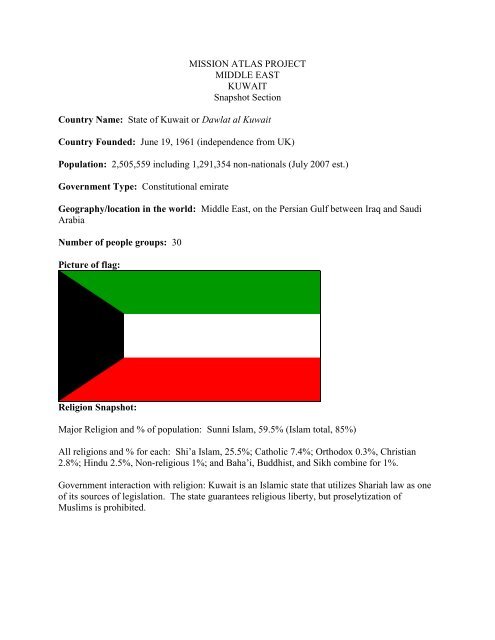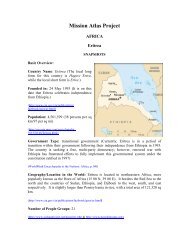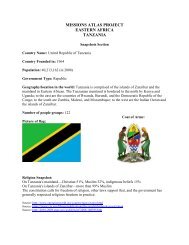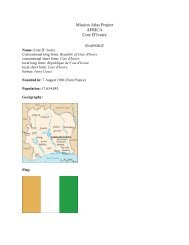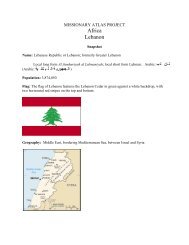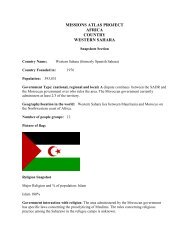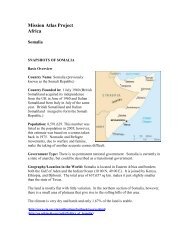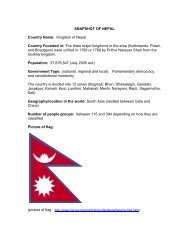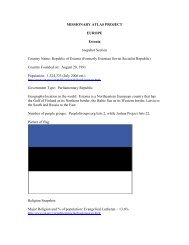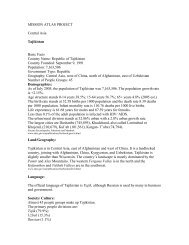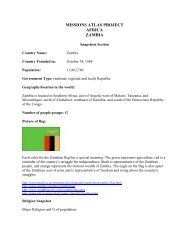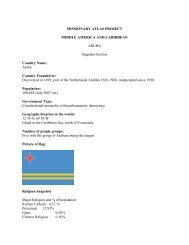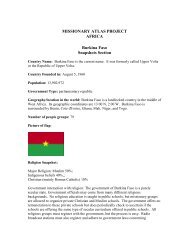Kuwait Profile.pdf - WorldMap
Kuwait Profile.pdf - WorldMap
Kuwait Profile.pdf - WorldMap
Create successful ePaper yourself
Turn your PDF publications into a flip-book with our unique Google optimized e-Paper software.
MISSION ATLAS PROJECTMIDDLE EASTKUWAITSnapshot SectionCountry Name: State of <strong>Kuwait</strong> or Dawlat al <strong>Kuwait</strong>Country Founded: June 19, 1961 (independence from UK)Population: 2,505,559 including 1,291,354 non-nationals (July 2007 est.)Government Type: Constitutional emirateGeography/location in the world: Middle East, on the Persian Gulf between Iraq and SaudiArabiaNumber of people groups: 30Picture of flag:Religion Snapshot:Major Religion and % of population: Sunni Islam, 59.5% (Islam total, 85%)All religions and % for each: Shi‘a Islam, 25.5%; Catholic 7.4%; Orthodox 0.3%, Christian2.8%; Hindu 2.5%, Non-religious 1%; and Baha‘i, Buddhist, and Sikh combine for 1%.Government interaction with religion: <strong>Kuwait</strong> is an Islamic state that utilizes Shariah law as oneof its sources of legislation. The state guarantees religious liberty, but proselytization ofMuslims is prohibited.
<strong>Kuwait</strong> Country <strong>Profile</strong>Basic FactsCountry Name:State of <strong>Kuwait</strong> or Dawlat al <strong>Kuwait</strong>; informally, <strong>Kuwait</strong> or al <strong>Kuwait</strong>.Demographics:<strong>Kuwait</strong> has a population of 2,505,559 that includes 1,291,354 non-nationals. Nearly all of<strong>Kuwait</strong>‘s population is urban, living in <strong>Kuwait</strong> city or its suburbs.Divided by age groups, 26.7% of the population is aged 0-14 years, 70.5% of the population is15-64 years, and 2.8% of the population is over 65 years of age; males outnumber females inevery age group.The population of <strong>Kuwait</strong> grows at a rate of 3.561%, with 21.95 births and 2.39 deaths per 1000people. Life expectancy at birth is 76.25 years for males and 78.52 years for females. Anaverage of 2.86 children is born per woman.The net migration rate is 16.05 per 1000 people.Ethnically, 45% of the population is <strong>Kuwait</strong>i Arab, 35% is Arab of a different origin (such asEgyptian, Palestinian, Iraqi, Jordanian, etc.), 9% is South Asian, 4% is Iranian, and 7% is ofother various ethnic origins. Nearly all who hold citizenship in <strong>Kuwait</strong> are Arab; being Muslimis a requirement for citizenship.https://www.cia.gov/library/publications/the-world-factbook/geos/ku.htmlhttp://encarta.msn.com/encyclopedia_761563200/<strong>Kuwait</strong>_(country).htmlLanguage:Arabic is the official language of <strong>Kuwait</strong>. The Arabic language exists in several forms,including Classical Qur‘anic Arabic, Modern Standard Arabic, and local dialects of Arabic.Classical Arabic is viewed as the purest form of the language, that which was handed down fromheaven and today is known primarily to scholars.Modern Standard Arabic is the language of literature and certain types of television and formal,official speeches; it is intelligible to the speakers of most Arabic dialects, but only the welleducated speak it. Local spoken dialects vary across the Arab and Islamic world. Pronunciation,vocabulary, and even grammar may have nuanced or stark differences. <strong>Kuwait</strong>is speak a dialectof Arabic, Gulf Arabic, that is common to Iraq, Bahrain, Iran, <strong>Kuwait</strong>, Oman, Qatar, SaudiArabia, the United Arab Emirates, and Yemen. Arabic, in general, is a poetic language and,because it is associated with the Quran, and subsequently viewed by Muslims as the language ofthe word of God, Arabic speakers are proud of and profoundly connected to their language.
English is also widely understood in <strong>Kuwait</strong>; it is taught in schools as a second language and isused in some businesses and by foreign residents and students. Farsi (the national language ofIran) and Urdu (the national language of Pakistan, also widely spoken in India) are spokenamong non-national residents of <strong>Kuwait</strong>.https://www.cia.gov/library/publications/the-world-factbook/geos/ku.htmlWorldmark Encyclopedia of the Nations: Asia and Oceania, 10 th edition, 306.http://www.kwintessential.co.uk/resources/global-etiquette/kuwait-country-profile.htmlWorldmark Encyclopedia of Cultures and Daily Life, volume 3: Asia and Oceania, pg 418-423.Society/Culture:Islam is the official religion of all citizens in <strong>Kuwait</strong> and is a culturally dominant force in thecountry. Islamic holidays and feasts are celebrated based on a lunar calendar and therefore cyclethroughout the Gregorian calendar over time. These holidays include Eid al Fitr, whichconcludes the Ramadan fast, Eid al Adha, which follows the time of annual pilgrimage (Hajj),the first of Muharram (Islamic New Year‘s Day), and the night of Mohammed‘s ascension toheaven (Eid al Isra‘ wa al Miraj). Friday is the Muslim day of rest and businesses and schoolsclose that day. Aspects of folk Islam, which include superstitious fear of evil spirits and cursesand use of charms and amulets, are present in <strong>Kuwait</strong>, but they are tempered by the Wahhabiinfluence that stresses more orthodox Islamic beliefs. <strong>Kuwait</strong>is differentiate between theculturally cosmopolitan and liberal residents of ―inner‖ <strong>Kuwait</strong> and the culturally conservativeand tribal residents of ―outer‖ <strong>Kuwait</strong>.Births and weddings are causes for great celebration and feasting in <strong>Kuwait</strong>. Families arrangemost marriages and women typically marry between the ages of 20 and 25. Married women in<strong>Kuwait</strong> retain their maiden names out of respect for their family heritage. The birth of sons isespecially relished; male babies are circumcised seven days after birth. Family life is veryimportant to <strong>Kuwait</strong>is and extended families often live in the same home with, or at least nearby, other relatives.Arab culture, with its emphasis on generous hospitality, is prevalent in <strong>Kuwait</strong>. Interactionsbetween men and women who are not relatives is limited, but within families greetings are warmand include kisses on the cheek. At the beginning of an encounter, it is common to exchange along series of questions about health, family, work, and other interests as an expression ofconcern and intimacy. Arabs are known for their loud, spirited conversations, which are filledwith hand gestures; touching and sitting or standing close to others while talking is also common.Socializing among families and in homes is the major leisure activity of <strong>Kuwait</strong>is. Homes oftenhave an external structure designed for receiving and entertaining guests. Recreational activitiesinclude team sports, such as soccer, and sea-sports, such as fishing, yachting, and sailing.<strong>Kuwait</strong>i hosts commonly offer tea and coffee to guests. Teas are often flavored with saffron ormint and coffee is spiced with cardamom. A wide variety of food is available in <strong>Kuwait</strong> throughimports and the cuisines of many other countries are enjoyed. Traditional <strong>Kuwait</strong>i dishes ofteninclude mutton, chicken, or fish served spiced over rice. Consumption of dates and yoghurtreflects the Bedouin ancestry of many <strong>Kuwait</strong>is.
<strong>Kuwait</strong>i men wear a modernized form of their traditional gown, called a dishdasha; on theirheads is a traditional Arab headdress. Women wear a wide variety of clothing types, fromtypical western wear to loose gowns and headscarves. Both men and women wear perfumeshabitually.More than half of <strong>Kuwait</strong>‘s population does not hold <strong>Kuwait</strong>i citizenship. These immigrantscame to <strong>Kuwait</strong> for employment. The majority of the workers come from other Arab countries,but significant numbers of others come from Iran, India, Pakistan, Bangladesh, Sri Lanka and thePhilippines. There is also a citizenship-less population within <strong>Kuwait</strong> who are known as bidun;they claim that they should be rightful citizens of <strong>Kuwait</strong> because their families have lived in<strong>Kuwait</strong> for generations, but the government denies the factuality of their assertion and considersthem only immigrants. Social distinctions between citizens and non-citizens produce substantialstrain between the classes. Foreign workers often feel discriminated against and looked downupon despite the services that they provide. <strong>Kuwait</strong>i nationals often view foreigners withsuspicion and are concerned about their country‘s security in light of the mass of foreignerspresent. The government has restrictions in place to limit the marriage of <strong>Kuwait</strong> citizens toforeigners. Oil wealth precipitated the division of labor within <strong>Kuwait</strong>; financial resources haveallowed <strong>Kuwait</strong>is to improve the education of their citizens dramatically, therefore <strong>Kuwait</strong>ishave been able to fill the highest-level positions on the job market. Success in these high-payingoccupations has led to less need for additional family members to work lower paying jobs orperform tasks of a menial status. These preferences left a bulk of lower status jobs open forforeigners who were willing to fill them, often taking the jobs and remitting their salaries to theirfamilies in their home countries.Though official censorship has decreased since 1992, freedom of press is not a guarantee in<strong>Kuwait</strong>. Criticism of the emir is prohibited and remarks against policy and ministers mustremain impersonal and be carefully measured. Non-nationals have far fewer rights andprivileges in this regard than <strong>Kuwait</strong>i citizens do.http://encarta.msn.com/encyclopedia_761563200/<strong>Kuwait</strong>_(country).htmlhttp://www.kwintessential.co.uk/resources/global-etiquette/kuwait-country-profile.html cultural and etiquette infoLibrary of Congress Country Studies: <strong>Kuwait</strong> http://lcweb2.loc.gov/frd/cs/cshome.htmlWorld Christian Encyclopedia, second edition, Vol. 1: The World By Countries, p 437-38.Worldmark Encyclopedia of Cultures and Daily Life, volume 3: Asia and Oceania, pg 418-423.Government:<strong>Kuwait</strong>‘s official English name is ―State of <strong>Kuwait</strong>,‖ which in Arabic is Dawlat al Kuwayt. Thegovernment is a constitutional emirate, in which the position of emir is hereditary. Theconstitution has been in effect since November 11, 1962. Civil law forms the basis of the legalsystem and Islamic law dictates legal code regarding personal matters. Adults who have beencitizens for longer than 20 years are eligible to vote, excepting police and military personnel.Women received the right to vote in 2005. Popular involvement in government has increasedsignificantly in recent years.The chief of state is Emir Sabah al-Ahmad al-Jabir al-Sabah, who came to power on January 29,2006. Nawaf al-Ahmad al-Jabir al-Sabah is the Crown Prince. All emirs must come from theancestral line of Mubarak al-Sabah, who founded <strong>Kuwait</strong>. The Prime Minister, appointed by the
emir, is Nasir Muhammad al-Ahmad al-Sabah. Jabir Mubarak al-Hamad al-Sabah is the FirstDeputy Prime Minister; Muhammad al-Sabah al-Salim al-Sabah and Faysal al-Hajji serve asDeputy Prime Ministers. The Prime Minister appoints the Council of Ministers with theapproval of the Emir. It is customary that the most important cabinet positions are given tomembers of the al-Sabah family. There are no elected officials in the Executive branch ofgovernment.The Legislative branch of government is the National Assembly or Majlis al-Umma. Voterselect the 50 members of the National Assembly by popular vote to 4-year terms of service.Creation of laws is exclusively under the purview of the National Assembly. Though nottechnically illegal, the formation of political parties is not permitted; however, there arelegislative blocs within the National Assembly that function much the way political partieswould. Of the 50 member seats, the Sunni Islamic Bloc holds 17 seats, the Popular Bloc has 9,the liberal National Action Bloc has 8, and independents hold the remaining 16 seats. Membersof the Council of Ministers also vote alongside members of the National Assembly.The High Court of Appeal, also known as the Supreme Court heads the judicial branch ofgovernment. The primary and appellate courts are the other two main courts of <strong>Kuwait</strong>. Islamiclaw dictates matters of personal concern, such as marriage, divorce, and inheritance, but thecases are handled through the regular court processes. Other laws are based on European legalsystems. Specialized courts handle cases involving the constitution, military, and administrativeissues.The capital city is the city of <strong>Kuwait</strong>. <strong>Kuwait</strong> is divided into 6 governorates: Al Ahmadi, Al‗Asimah, Al Farwaniyah, Al Jahra‘, Hawalli, and Mubarak Al Kabir. The largest cities in<strong>Kuwait</strong> are <strong>Kuwait</strong> City, As Salimiyah (pop. 130,215), Jalibash Shuyukh (pop. 102,178),Hawalli (pop. 82,238), Al Wafrah, and Safat.<strong>Kuwait</strong>is celebrate the anniversary of their independence from the United Kingdom, whichoccurred June 19, 1961. February 25 is commemorated as National Day (since 1950) andFebruary 26 th is Liberation Day; however, neither day is ―celebrated‖ in deference to <strong>Kuwait</strong>iswho are missing and presumably still being held captive in Iraq since of time of Iraqi occupation.The <strong>Kuwait</strong>i Military has 4 branches: the Land Forces, the <strong>Kuwait</strong>i Navy, the <strong>Kuwait</strong>i Air Force,and the National Guard. <strong>Kuwait</strong> has 737,292 males and 405,207 females fit for military service.Compulsory and volunteer military service for males begins at age 18.<strong>Kuwait</strong> is a member in a number of international organizations. Among the more notable ofthese is its participation in the United Nations, the Arab League, and Gulf Cooperation Council.The <strong>Kuwait</strong>i flag was designed in 1961 to resemble of the Arab Revolt flag of World War I. Thedesign consists of three horizontal bands of green, white, and red; on the hoist side is a blacktrapezoid.https://www.cia.gov/library/publications/the-world-factbook/geos/ku.htmlhttp://www.emporis.com/en/wm/co/?id=kuwaithttp://encarta.msn.com/encyclopedia_761563200/<strong>Kuwait</strong>_(country).htmlWorld Christian Encyclopedia, second edition, Vol. 1: The World By Countries, p 437.Worldmark Encyclopedia of Cultures and Daily Life, volume 3: Asia and Oceania, pg 418-423.
Economy:Though geographically small, <strong>Kuwait</strong> possesses great wealth due to its vast reserves of crude oil(10% of the worldwide supply). Prior to the discovery of oil in the 1930s, sea trade and pearlexports supported the economy. Currently, ninety-five percent of its export profits and 80% of itsgovernment revenue are generated by the sale of oil. Oil revenues are frequently used to earn aprofit themselves in foreign investment markets. <strong>Kuwait</strong>i law mandates that 10% of oil revenuesare deposited in a trust a trust that will assist <strong>Kuwait</strong> when its oil reserves one day dry up; atcurrent production levels, that day will come in approximately 250 years.Agriculturally, <strong>Kuwait</strong> produces almost nothing besides fish; virtually all other foods must beimported. Fresh water is such a scarce commodity that 75% of the supply must be distilled orimported. <strong>Kuwait</strong>‘s Gross Domestic Product (GDP) was $55.91 billion in 2006 and increased ata rate 12.6%. The per capita GDP is $23,100.The country‘s labor force is 1.136 million people, 80% of which are non-<strong>Kuwait</strong>i. <strong>Kuwait</strong>‘sunemployment rate is a low 2.2%. <strong>Kuwait</strong>‘s budget consists of $59.58 billion in revenues and$33.62 billion in expenditures.The country‘s primary industries are petroleum, petrochemicals, cement, shipbuilding and repair,water desalination, food processing, and construction materials. All of <strong>Kuwait</strong>‘s energyproduction is from fossil fuels. Oil is produced at a rate of 2.418 million barrels per day,335,000 of which are consumed nationally and 1.97 million of which are exported. The oilreserve is estimated at 96.5 billion barrels.<strong>Kuwait</strong> produces and consumed 9.7 billion cubic meters of natural gas yearly and has 1.572trillion cubic meters of natural gas in reserves. Exports of <strong>Kuwait</strong> include oil and refinedproducts and fertilizer; these products go primarily to Japan, South Korea, Taiwan, Singapore,the U.S, the Netherlands, and China. Imports to <strong>Kuwait</strong> primarily include food, constructionmaterials, vehicles and parts, and clothing; these products come from the U.S., Japan, Germany,Saudi Arabia, China, the U.K., and Italy.The currency of <strong>Kuwait</strong> is the <strong>Kuwait</strong>i dinar (KD) which exchanges with the U.S. dollar at a rateof 0.29 KD per dollar.The <strong>Kuwait</strong>i government provides free health care to all residents of the country. Housingsubsidies are also available for <strong>Kuwait</strong>is. While these benefits are substantial, the result is anunusual economic dependence on government.Human trafficking is a serious humanitarian issue in which <strong>Kuwait</strong> is involved. Some foreignworkers from South and Southeast Asia who enter the country legally as domestic laborers havebeen forced into servitude and physically and sexually abused. In some cases, the workers‘passports are taken from them and their wages are withheld, leaving them with no recourseagainst their employers. Other reports indicate that foreign workers taken into police custodyhave disappeared or died.https://www.cia.gov/library/publications/the-world-factbook/geos/ku.html
http://encarta.msn.com/encyclopedia_761563200/<strong>Kuwait</strong>_(country).htmlWorld Christian Encyclopedia, second edition, Vol. 1: The Word By Countries, p 437.http://www.lonelyplanet.com/worldguide/destinations/middle-east/kuwaitLiteracy:<strong>Kuwait</strong>‘s population is 93.3% literate. Public education is free for children between the ages of 6and 13. <strong>Kuwait</strong> University may be attended at no cost and the government sponsors manystudents to study in universities abroad. <strong>Kuwait</strong>‘s public educational system is well fundedbecause of the country‘s oil wealth.https://www.cia.gov/library/publications/the-world-factbook/geos/ku.htmlhttp://encarta.msn.com/encyclopedia_761563200/<strong>Kuwait</strong>_(country).htmlhttp://www.kuwait-info.comLand/Geography:<strong>Kuwait</strong> is a Middle Eastern country strategically located at the northwest tip of the Persian Gulfalong a 499km coastline. Several islands offshore are also part of <strong>Kuwait</strong>, though only one,Faylakah, is inhabited. <strong>Kuwait</strong>‘s total area is 17,820 square kilometers. Comparativelyspeaking, it is slightly smaller than the U.S. state of New Jersey. <strong>Kuwait</strong>‘s neighboring countriesare Iraq to the north and west (240km shared border) and Saudi Arabia to the south and west(222km shared border). Directly across the Persian Gulf, <strong>Kuwait</strong> faces Iran. With a dry desertclimate, <strong>Kuwait</strong>‘s summers, which last from May to October, are scorching, reaching averagetemperatures of over 113°F (45°C); in August and September, winds from the Gulf raisehumidity levels to 90%. The months between November and April are the most pleasant of theyear. <strong>Kuwait</strong>‘s cool winters, averaging 56°F (13.5°C) in January, are brief and nighttimetemperatures occasionally reach freezing point.<strong>Kuwait</strong>‘s terrain is mostly flat, though its gravely desert sand dunes roll up and down. Itsshoreline rests at sea level and its highest point of elevation is a mere 306 meters. Only 0.84% of<strong>Kuwait</strong>‘s land is arable and 130 sq km of land are irrigated; annual rainfall is a mere 5 inches.<strong>Kuwait</strong> city is located on <strong>Kuwait</strong> Bay, which is the only deepwater harbor on the Persian Gulf‘swest coast, making the location strategic and prosperous for the <strong>Kuwait</strong>. The country‘s naturalresources include petroleum, fish, shrimp, and natural gas. Because fresh water resources are solimited, <strong>Kuwait</strong> has developed desalination facilities, which are among the best in the world.Weather related hazards include heavy rains from October to April that can be damaging to roadsand houses built on sandy soil and sandstorms, which are common from March to August.Pollution of air and water and desertification are among <strong>Kuwait</strong>‘s most serious environmentalissues. The Iraqi war caused extensive damage to the <strong>Kuwait</strong>i environment, some of which maybe irreparable.The animals that are native to <strong>Kuwait</strong> are those common to desert areas of Arabia; these includefoxes, jackals, badgers, wild and sand cats, gerbils, jerboas (jumping desert rodents), hedgehogs,and hares, as well as lizards, geckos, snakes, fish and migratory birds. Vegetation is scarce,excepting thorns and shrubs; however, when rainfall comes sufficiently, many desert grasses andflowers grow in great variety.https://www.cia.gov/library/publications/the-world-factbook/geos/ku.htmlhttp://encarta.msn.com/encyclopedia_761563200/<strong>Kuwait</strong>_(country).html
World Christian Encyclopedia, second edition, Vol. 1: The World By Countries, p 437-38.Worldmark Encyclopedia of the Nations: Asia & Oceania, 10 th ed., p 305.http://www.alsarhan.net/Animals/index.htmHistoryThe lands surrounding the Persian Gulf have a long history of interaction and trade with foreigncultures and peoples; trade itself was the impetus for establishing settlements in what is now<strong>Kuwait</strong>. A Bronze Age civilization existed on the island of Faylakah off the <strong>Kuwait</strong>i coast asearly as 2800 B.C. The civilizations of ancient Mesopotamia, in what is modern-day Iraq, wereable to produce surpluses of food to trade for the lumber and mineral resources that their landslacked.Trade by sea with Oman and India became a very profitable endeavor during ancient times formany ports established around the Persian Gulf; the 6 th century B.C. was a high point of thistrade activity. The domestication of camels and the development of inland trade routes broughtgreater interaction between those native to the Gulf coast and Arabs from the interior and thusthe Arabization of the Gulf began. In the 4 th century B.C., Greeks under Alexander‘s rule built afort on the island of Faylakah, the remains of which still stand today; however, Greek presence inthe Gulf ended by 250 B.C. The Parthian and Sassanian Empires of Persia held successiveinterests in the Gulf for the following 800 years. The 7 th century A.D. brought great change toArabia, including <strong>Kuwait</strong>, as Islamic rule swiftly spread and decisively took control of theregion.In the 17 th century, the Khalid family ruled much of eastern Arabia including an area at the top ofthe Persian Gulf, known as al-Qurain, where the reigning sheik built a fort as a summer home.―<strong>Kuwait</strong>,‖ a derivative of the Arabic word for fort, became the name of this region after Arabsettlers from the Najd of the Arabian interior migrated to the region in the early 18 th century.These settlers were from the al-Aniza tribe and Bani Utub clan. Although it was little more thana tent-village in the beginning, <strong>Kuwait</strong>‘s population and trading industry, with camels and sailingvessels for pearling and trade, grew quickly. By 1756, the settlers chose the al-Sabah family tolead them, and thus, the al-Sabah dynasty, which continues to rule <strong>Kuwait</strong> today, began underthe leadership of Sheik Sabah ‗Abd ar-Rahim.The al-Sabah dynasty was firmly established; however, they existed in the ominous shadow ofthe expansive Ottoman Empire. Although the Ottoman Turks claimed that <strong>Kuwait</strong> was includedin their Basra territory, it seems that direct rule by the Ottomans did not actually have muchinfluence over <strong>Kuwait</strong>. By the end of the 19 th century, however, the threat to <strong>Kuwait</strong>isovereignty was real as the Arab tribes of ar-Rashid (backed by the Ottoman Empire) and as-Saud jockeyed for political control of the region. <strong>Kuwait</strong>i Sheik Mubarak al-Sabah requestedprotection from the British, who accepted <strong>Kuwait</strong> as an autonomous British protectorate in 1899in order to keep <strong>Kuwait</strong> out of the control of the Turks, Germans, and Russians, who all haddesigns on <strong>Kuwait</strong>‘s strategic location and coal resources; Britain also sought to protect theirown interests in the Middle East. World War I saw the end of the Ottoman Empire but did notsettle territorial disputes in the area. The 1920s brought continuing conflict with the as-Saud, in
the Nejd, and Iraq over borders, sovereignty and gulf access; <strong>Kuwait</strong> relied on the British tomediate these issues and to assist them economically as their pearling and fishing industries werecollapsing. Established borders became even more economically important by the end of the1930s when oil was first discovered in <strong>Kuwait</strong>. Following World War II, the oil industry in<strong>Kuwait</strong> began large-scale drilling and exporting, which completely transformed the economy andprosperity of the small country. <strong>Kuwait</strong> remained a protectorate until June 19, 1961 whenBritain granted them full independence.Following independence, <strong>Kuwait</strong> and Saudi Arabia peaceably renegotiated their bordersconcerning a neutral zone, which they divided between them. However, border disagreementswere not settled so easily and definitively with Iraq. From 1961 and onwards, Iraq alternatelyclaimed sovereignty over <strong>Kuwait</strong> and then signed agreements recognizing <strong>Kuwait</strong>‘s autonomy.This waffling continued until Iraq militarily invaded and occupied <strong>Kuwait</strong> on August 2, 1990.Iraq asserted their right to annex <strong>Kuwait</strong> on arguments of historic control and as means ofretribution for alleged economic attacks on Iraq by <strong>Kuwait</strong>.Iraq claimed that <strong>Kuwait</strong> had stolen oil located in reserves that straddled their borders and that<strong>Kuwait</strong> had glutted the oil market by over producing oil, which led to a drop in market prices.<strong>Kuwait</strong>‘s royal family, as well as many of her citizens, fled to Saudi Arabia for protection. ByFebruary 26, 1991, a U.S.-led coalition of forces removed the Iraqi military from <strong>Kuwait</strong>;unfortunately, Iraqi forces destroyed, burned, polluted, and looted much of <strong>Kuwait</strong> as theywithdrew. <strong>Kuwait</strong> was restored to the al-Sabah government and a new National Assembly waselected; extensive rebuilding and cleanup efforts were undertaken to restore <strong>Kuwait</strong> to its prewarstatus.In recent years, elections have demonstrated tensions within the country between the al-Sabahgovernment and opposition Islamic and Liberal political groups. In 2003, <strong>Kuwait</strong> allowed theU.S. military and their allies to gather on the <strong>Kuwait</strong>-Iraq border to begin war efforts aimed atremoving Saddam Hussein from power. That same year, the government officially separated theroles of Prime Minister and Crown Prince.In 2005, the <strong>Kuwait</strong>i parliament legalized suffrage for women and the first female cabinetminister was elected; women were first able to exercise their votes in the 2006 elections. Earlyin 2006 Sheikh Jaber al-Ahmad al-Jaber al-Sabah died and was succeeded by Crown Price SheikSaad al-Abdullah al-Salim al-Sabah; however, the government declared Sheik Saad unfit to ruleafter only nine days as emir because of his ill-health and Prime Minister Sheik Sabah al-Ahmadal-Jaber al-Sabah became the new emir.Traditionally, the position of emir has alternated between members of two branches of the al-Sabah family, those descended from Mubarak‘s son Jaber and those descended from his sonSalim. However, the current emir, Sheik Sabah, caused tension among the branches by naminghis brother crown prince and his nephew prime minister, placing all top positions in the hands ofthe al-Jaber branch of the family.Library of Congress Country Studies: <strong>Kuwait</strong>http://encarta.msn.com/encyclopedia_761563200/<strong>Kuwait</strong>_(country).htmlhttp://news.bbc.co.uk/2/hi/europe/6930285.stm
Worldmark Encyclopedia of the Nations: Asia & Oceania, 10 th ed., p 307-08.Shttp://www.kuwait-info.org/cphistory.htmlhttp://news.bbc.co.uk/2/hi/middle_east/country_profiles/791053.stmhttp://en.wikipedia.org/wiki/Al-Sabahhttp://en.wikipedia.org/wiki/AnaizaChristian HistoryIn ancient times, the residents of <strong>Kuwait</strong>, and Arabia in general, were pantheistic. Araband Mesopotamian Christians migrating to <strong>Kuwait</strong> first brought Christianity to the area. By the7 th century, the <strong>Kuwait</strong>i population was almost exclusively Muslim and <strong>Kuwait</strong> remains anIslamic state today.Foreign workers comprise much of the membership of the various churches present in <strong>Kuwait</strong>.When the Iraqi War began in the early 90s, many foreign Christians fled the country, leavingbehind a very sparse population. Since that time, Christian foreign workers have returned, andmost of the predicted growth of Christianity in <strong>Kuwait</strong> is thought to come from this group, ratherthan from indigenous <strong>Kuwait</strong>is. Researchers predict that it is more likely that the numbers of<strong>Kuwait</strong> Muslims will decrease because people become non-religious than for Muslim numbers todecrease because they are converting to Christianity.World Christian Encyclopedia, second edition, Vol. 1: The World By Countries, p 437-38.Worldmark Encyclopedia of Cultures and Daily Life, volume 3: Asia and Oceania, pg 418-423.Library of Congress Country Studies: <strong>Kuwait</strong>Non-ChristianIslamReligionBy the 7 th century, the <strong>Kuwait</strong>i population was almost exclusively Muslim and <strong>Kuwait</strong> remainsan Islamic state today.Sunni Muslim—Malikite rite, Wahhabi influenced: (59.5%) The largest religious groupin <strong>Kuwait</strong> adheres to the Sunni branch of Islam.Following the death of Mohammad, Prophet of Islam, his followers debated who therightful successor and leader of Islam was to be. The majority group, those who wouldbecome known as Sunni Muslims, supported Abu Bakr, Mohammad‘s father-in-law, inbecoming the first Caliph; conversely, Shi‘a Muslims believed that the Caliphate shouldfollow Mohammad‘s bloodline and they proposed Mohammad‘s cousin and son-in-law,Ali, as the Prophet‘s successor.Sunnis represent an estimated 85% percent of the Muslim world, and in <strong>Kuwait</strong>, theyrepresent 59.5% of the population; when only <strong>Kuwait</strong>i citizens are considered, 70% areSunni Muslim. Among Sunni Muslims, there are four schools of interpretation forreligious law: Hanafi, Shafi‘i, Maliki, and Hanbali. Sunni Muslims in <strong>Kuwait</strong> belong to
the third largest school, Maliki, named for its founder, Imam Malik. The Maliki schoolbases its interpretations of Islamic law on five sources.The first four sources are common to all Islamic schools of interpretation, but the last isunique to the Malikite rite. These sources are the Qur‘an, the Sunna (example) of theProphet, the consensus of traditional Muslim scholars (ijma‘), analogical reasoning(qiyas) which applies principles of established laws to new situations in which a ruling isneeded, and the practice of the people of Medina. This school emphasizes the example ofthe people of Medina over and above the sayings recorded in the hadith, because Medinawas the city where Mohammed lived and died and where most of Mohammed‘s closestcompanions lived out the teachings of Islam. Imam Malik‘s select collection of sayingsfrom Medina carries the title ―Al-Muwatta,‖ which means ―The Approved.‖Like all Sunni Muslims, <strong>Kuwait</strong>i Sunnis practice the Five Pillars of Islam (consisting ofthe proclamation of faith, prayer, alms giving, fasting, and pilgrimage) and uphold the sixarticles of belief (aqidah) given by Mohammad (belief in Allah, his angels, his books, hisprophets, Judgment Day, and fate). Members of the Maliki rite perform slightly differentmovement and rituals during prayer, such as: leaving their hands at their sides rather thanoverlapped in front of them, looking out toward the Kaaba during prayer, encouraging thereciting of the Bismillah before praying the Fatihah, additional hand movements whensitting, and limiting the number of greetings after prayer. Islam is a comprehensivereligion, directing both the private and public lives of its followers and making nodistinction between secular and sacred.<strong>Kuwait</strong>i Muslims are influenced by Wahhabism, which is considered a reformmovement, by some, and a sect of Islam, by others; it is based on the teachings ofMuhammad ibn Abd-al-Wahhab. The crux of Wahhabism is that Muslims should studyand adhere to the teachings of the Qur‘an and hadith rather than unthinkingly followscholars and tradition. They distain many ―un-Islamic‖ and ―polytheistic‖ practiceswhich are common to many Muslims, such as praying at the tombs of saints, listening tohymns which praise Mohammed and celebrating his birthday, describing God withprimarily non-literal images, and use of innovative aspects of worship.http://en.wikipedia.org/wiki/Malikihttp://en.wikipedia.org/wiki/Islamhttp://en.wikipedia.org/wiki/WahhabismShi’a Muslims: (25.5%) The Shi‘a branch of Islam makes up approximately 15% ofMuslims worldwide and in <strong>Kuwait</strong> they are 25.5% of the total population. Of <strong>Kuwait</strong>icitizens, 30% are Shi‘a.The majority of foreign Muslims in <strong>Kuwait</strong> are Shi‘a Muslims. Shi‘as maintain adifferent Islamic tradition than Sunnis that translates into varied beliefs and practices.Shi‘as uphold practices in addition to the Five Pillars which include paying a tax to theimam, the struggle to please Allah (jihad), commanding what is good, forbidding what isevil, loving the family of Mohammed and dissociating from the enemies of Mohammed‘shouse.http://en.wikipedia.org/wiki/Shi%27a
http://en.wikipedia.org/wiki/Ahl_al-BaytWorld Christian Encyclopedia, second edition, Vol. 1: The World By Countries, p 436-37.Other: Members of <strong>Kuwait</strong>‘s foreign communities represent numerous religious groupsindigenous to their home countries. From South Asia come religious adherents who are Hindu(2.5% of total <strong>Kuwait</strong>i population), Muslim (included in statistics above), Sikh (0.2%),Parsi/Zoroastrian (statistic unavailable), Baha’i (0.5%) and Buddhist (0.3%). Baha‘is in <strong>Kuwait</strong>may also come from Iran. The numbers associated with these religions in <strong>Kuwait</strong> rise and fall asforeign workers come and go; they are not solidly established, nor are they native (exceptingIslam).World Christian Encyclopedia, second edition, Vol. 1: The World By Countries, p 436-37.Jehovah’s Witnesses: (
This Latin-rite church contains a compilation of different Catholic-rite congregants: 58% ofmembers are themselves Latin-rite, while others are Melkite, Maronite, Chaldean, and other).This church has 4 congregations of 70,000 adult adherents in <strong>Kuwait</strong>, making Catholics thelargest Christian denomination in <strong>Kuwait</strong>.World Christian Encyclopedia, second edition, Vol. 1: The World By Countries, p 437-38.Ancient Church of the East:This church of 95 adult adherents is part of the Assyrian or Nestorian Church. These titles referto the Nestorian controversy and the schism that formed the church following the Council ofEphesus in 431 A.D. The Nestorian controversy involved a belief that in Christ‘s one person twounmingled natures existed; in effect, this meant that the human person of Jesus could experiencethings which the divine nature of Jesus did not, such as suffering and being born of a woman.The Nestorian church of today holds to a belief on this doctrine that was modified by Babai theGreat and is much closer to the Catholic and Orthodox Christology. The name ―Nestorian‖persists to distinguish the church from other Orthodox churches. The patriarch of the AncientChurch of the East is in the United States, but this congregation is led by a deacon who isresident in <strong>Kuwait</strong>.http://www.nestorian.org/http://en.wikipedia.org/wiki/NestorianismWorld Christian Encyclopedia, second edition, Vol. 1: The World By Countries, p 437-38.Armenian Apostolic Church, Vicariate of <strong>Kuwait</strong>:This church, also known as the Gregorian Church, is one of the oldest Christian denominations,begun in the 1 st century by the Apostles, Bartholomew and Jude; St. Gregory was the firstofficial head of the church. The church established itself in <strong>Kuwait</strong> in 1958 with its own priest,under the patriarchate of Cilicia, Lebanon. There is 1 congregation of this church in <strong>Kuwait</strong>,consisting of 1280 adult members. They are the second largest orthodox denomination in<strong>Kuwait</strong> and operate a school with 600 students.World Christian Encyclopedia, second edition, Vol. 1: The World By Countries, p 437-38.Coptic Orthodox Church:This church of Egyptian residents and workers has 2congregations of 1890 adult adherents and belongs to the patriarchate of Alexandria. The churchbegan in Egypt in the 1 st century, planted by the Apostle Mark, and became distinct from theCatholic Church in 451, following the Council of Chalcedon; its congregations are presentworldwide. The church has a resident priest and a Coptic Papal representative in <strong>Kuwait</strong>.World Christian Encyclopedia, second edition, Vol. 1: The World By Countries, p 437-38.Greek Orthodox Church, Patriarchate of Antioch:This is <strong>Kuwait</strong>‘s largest Orthodox church; it has 2 congregations of 384 adherents. Since the1962 the church has a resident priest and though a well-established body, they choose to meet in
uildings belonging to protestant churches in the cities of <strong>Kuwait</strong> and Ahmadi. The GreekOrthodox Church operates a school with 700 students.World Christian Encyclopedia, second edition, Vol. 1: The World By Countries, p 437-38.Orthodox Syrian Church of India:This church of 496 adult adherents consists of Malayalis from the Indian state of Kerala. Thechurch has a resident priest and meets in the building of the National Evangelical Church in<strong>Kuwait</strong>.World Christian Encyclopedia, second edition, Vol. 1: The World By Countries, p 437-38.Christian or EvangelicalAnglican Church, Diocese of Cyprus and the Gulf:This congregation of 60 members is two-thirds British and one-third Arab. The church wasdeveloped of mixed Anglican traditions.World Christian Encyclopedia, second edition, Vol. 1: The World By Countries, p 437-38.Assemblies (Jehova Shammah):This congregation of 20 members is comprised of Indian missionaries from Hyderabad, AndhraPradesh, India. They are an independent Christian Brethren group who are fundamentalist,dispensationalist, and maintain open fellowship. The church (established in 1941 in Madras,Tamil Nadu, India) arose out of an indigenous, Indian church movement associated with theministry of Indian evangelist Bakht Singh. The name ―Jehova Shammah‖ comes from a Hebrew,Old Testament name meaning ―The Lord is There.‖World Christian Encyclopedia, second edition, Vol. 1: The World By Countries, p 437-38.Christian Brethren:This 50% Arab and 50% Indian congregation has 2 congregationsand 80 adult adherents. They are independent, fundamentalist, dispensationalist, and maintainopen fellowship.World Christian Encyclopedia, second edition, Vol. 1: The World By Countries, p 437-38.Isolated Radio Churches:This church is made up of isolated believers whose contact with the gospel has come over theArab Radio Network. There are 2,200 congregations and 30,000 adherents, who are primarilystudents.World Christian Encyclopedia, second edition, Vol. 1: The World By Countries, p 437-38.Mar Thoma Syrian Church. Diocese Bahya Kerala:This congregation of 310 adult adherents is a reformed orthodox church of Malayali, SouthIndians. They belong to the diocese of outside Kerala.World Christian Encyclopedia, second edition, Vol. 1: The World By Countries, p 437-38.
National Evangelical Church in <strong>Kuwait</strong>:This reformed or Presbyterian church consists of Arab, English, and Indian congregations.Established in 1903 and associated with the work of missionary Samuel Zwemer, the first Arabicservices of this church began in 1926. Each distinct type of congregation has a resident minister.World Christian Encyclopedia, second edition, Vol. 1: The World By Countries, p 437-38.Pentecostal Churches:There are 2 Arab Pentecostal congregations in <strong>Kuwait</strong>, which are comprised of 325 adultadherents. Many in this group are indigenous Arab evangelists.World Christian Encyclopedia, second edition, Vol. 1: The World By Countries, p 437-38.Other Protestant Churches:There are about 4 other protestant churches in <strong>Kuwait</strong> that do not fall into a grouping with any ofthe other churches listed above. These churches contain 69 adult adherents.World Christian Encyclopedia, second edition, Vol. 1: The World By Countries, p 437-38.00000People GroupsThe American (4466—Joshua Project) population in <strong>Kuwait</strong> is from the United States ofAmerica and speaks English. There is very little specific information available regarding thispopulation. Americans are likely in <strong>Kuwait</strong> for business or military purposes; a small number ofAmericans may be married to <strong>Kuwait</strong>i citizens.Approximately 10% of Americans are evangelical, 65% are Catholic or Orthodox, and theremaining are non-religious or part of another religious minority. It is likely that some of thenon-Christian Americans in <strong>Kuwait</strong> are Muslim and of these, some probably converted to Islamin order to marry a <strong>Kuwait</strong>i Muslim.http://www.joshuaproject.net/peopctry.php?rop3=110448&rog3=KU00000The Arabized Black (35,731—Joshua Project) of <strong>Kuwait</strong> are Gulf Arabic speakers. Ninety-fivepercent of this population is Sunni Muslim. At least 2.5% are evangelical Christians and theremaining population (
The Armenians (222,322—Joshua Project) of <strong>Kuwait</strong> are a primarily Orthodox Christian groupof Armenian speakers. Evangelical Christians comprise at least 5% of this population and theirnumbers have been increasing. During World War I, the Ottoman Empire expelled largenumbers of Armenians from their homeland, Armenia, which is east of Turkey and north of Iran.The Armenian population that survived the expulsion was scattered across the Middle East andmany of these remained there even after the establishment of the Republic of Armenia Littlespecific information is available about Armenians in <strong>Kuwait</strong>, but they are likely present asforeign workers.http://www.joshuaproject.net/peopctry.php?rop3=100516&rog3=KU11794The Assyrian (6700) population of <strong>Kuwait</strong> speaks the languages of Assyrian Neo-Aramaicand/or Turoyo. Assyrians are native to the Middle East, coming primarily from Iraq, Iran, Syria,and Turkey. Many Assyrians belong to the Ancient Church of the Near East, also known as theNestorian Church; others participate in the Jacobite Church, also known as the Syrian OrthodoxChurch. Orthodox affiliation significantly colors the culture of the people. Many Assyrianshave Christian names, celebrate Easter and Christians, and are proud of their religious andnational heritage. At least 5% of the Assyrian population is evangelical, and this percentage isgrowing as evangelical church planting movements multiply among the population. Under theOttoman empire in the early 1900s and recently in Iraq, the Assyrians have faced heavypersecution, which has caused them to scatter across the Middle East and also into Westerncountries; the Assyrian population of <strong>Kuwait</strong> may be part of this Assyrian diaspora.http://www.joshuaproject.net/peopctry.php?rop3=100574&rog3=KUhttp://mb-soft.com/believe/txh/orientor.htmhttp://www.peoplegroups.org/SimpleSearch.aspx?SearchTxt=http://www.ethnologue.com/show_language.asp?code=aiihttp://www.ethnologue.com/show_language.asp?code=tru42753The Bedouin (214,930) are descended from nomadic, desert herders indigenous to Arabia; theirtribes have traded, traveled, and resided in the Arabian deserts while maintaining ancient culturaltraditions for times long surpassing written history. The Bedouin value hospitality, honor, andtribal loyalty. Theirs is a sometimes romanticized and idealized culture among Arabs; however,among many modern and westernized <strong>Kuwait</strong>is, Bedouin may be viewed as fundamental,traditional, and backward. For those who continue to maintain it, the Bedouin lifestyle isstrenuous, requiring much labor just to ensure survival. In Arabic their name, Bedu, means―desert dwellers.‖ The language of this Bedouin group is Gulf Arabic. Today many Bedouinhave augmented their desert traversing with modern technology, such as trucks, cell phones, andsatellites; many others have settled in recent years and begun to pursue education, business, andcareers.The Bedouin are Sunni Muslims; Islam has been intimately linked with Bedouin culture from itsinception. There is little specific information available about Gulf Arabic speaking Bedouin in<strong>Kuwait</strong>. Among the same group in neighboring Saudi Arabia, there are a few known Christian
elievers, but no church planting is currently taking place; it may be assumed that their status in<strong>Kuwait</strong> is similar.http://www.joshuaproject.net/peopctry.php?rop3=114491&rog3=SAhttp://www.ethnologue.com/show_language.asp?code=afb00000The British (7291—Joshua Project) in <strong>Kuwait</strong> are likely there for business or diplomaticpurposes related to the oil industry or government. Britons are English speakers. Some Britonsmay be married to <strong>Kuwait</strong>i citizens. Before <strong>Kuwait</strong> became fully independent in 1961, it was aprotectorate of the British government; amicable ties between the citizens, businesspersons, andgovernments of both countries remain today. Little specific information is available on Britonsin <strong>Kuwait</strong>. The British population is an estimated 10% evangelical, with the majority of Britons(87%) belonging to churches of some kind, be they the Church of England, Church of Scotland,a variety of other Protestant churches or the Roman Catholic Church. Sizable minoritypopulations representing all other major world religions exist in the United Kingdom. The exactreligious makeup of Britons in <strong>Kuwait</strong> is unknown. Evangelical Britons, who already haveestablished business or personal ties to <strong>Kuwait</strong>, could make excellent partners in ministry andwitness to the <strong>Kuwait</strong>i people.http://www.joshuaproject.net/peopctry.php?rop3=102927&rog3=KU11796The Egyptian Arabs (28516) resident in <strong>Kuwait</strong> have come as skilled and unskilled laborers,taking advantage of the availability of jobs in <strong>Kuwait</strong>. The population of Egyptians in <strong>Kuwait</strong>rotates continually as workers come for a few years and then return home; new workers areconstantly coming to replace those that leave. The language spoken by this group is EgyptianArabic. Egyptians, like other foreign workers filling lower status jobs in <strong>Kuwait</strong>, are not alwaysfairly treated and may be subjected to harsh and degrading mistreatment. Recent news articlesreport such abuses as police officers pouring acid on Egyptian workers they suspected offalsifying work permits. If the Egyptians in <strong>Kuwait</strong> mirror the Egyptian population as a whole,about three quarters of them adhere to Sunni Islam. Much of the remaining group belongs toOrthodox Christianity, specifically of the Coptic variety. Less than two percent of EgyptianArabs are evangelical Christians. (Tie in church info). There are currently no mission agenciesengaging the Egyptian Arabs of <strong>Kuwait</strong>.http://www.khaleejtimes.com/DisplayArticleNew.asp?xfile=data/middleeast/2007/August/middleeast_Auhttp://www.joshuaproject.net/peopctry.php?rop3=102879&rog3=KUhttp://www.ethnologue.com/show_language.asp?code=arz46407The Filipinos (63,411) of <strong>Kuwait</strong> are part of the foreign laborer population and are Tagalogspeakingcitizens of the Philippines. Filipinos typically work as domestic servants and othertypes of laborers. There have been a number of international reports regarding the mistreatmentof Filipino foreign workers in <strong>Kuwait</strong>. The majority of Filipinos are Catholic or Orthodox(85%). Filipinos are 5% evangelical with a growing evangelical movement at work among them.Evangelical Filipinos could be mobilized as Christian witnesses to the people of <strong>Kuwait</strong>.http://www.peoplegroups.org/Detail.aspx?PID=46407
http://www.joshuaproject.net/peopctry.php?rop3=109692&rog3=KUhttp://www.iht.com/articles/ap/2007/08/12/africa/ME-GEN-<strong>Kuwait</strong>-Iraq-US-Embassy.php00000The French (4466—Joshua Project) in <strong>Kuwait</strong> are French-speaking citizens of France. Theirpresence in <strong>Kuwait</strong> is likely related to the French embassy or to business. The French are anestimated 2-5% evangelical, with the largest majority of French people (76%) belonging, at leastnominally, to Catholic or Orthodox religious groups.http://www.joshuaproject.net/peopctry.php?rop3=103059&rog3=KU00000The Greek (900—Joshua Project) in <strong>Kuwait</strong> are Greek-speaking citizens of Greece. They are in<strong>Kuwait</strong> on business, as embassy workers, clergy in the Greek Orthodox Church, or asarcheologists working on the island of Faylakah. Ninety percent of Greeks in <strong>Kuwait</strong> areOrthodox Christians. Less than 5% of this population is evangelical, but there are growingevangelical churches among them.11792Gulf Arabs (716,431), and specifically <strong>Kuwait</strong>i Arabs, have faced great changes in many aspectsof society and culture since the discovery of oil in their country in the 1930s. Their society hasmoved quickly toward industrialization, urbanization, and wealth. These changes, as well asgreater education and interaction with the West, have caused conflict at times with theirtraditional Arab and Islamic culture. Although oil wealth has served to repair physical andmaterial damage that resulted from the Iraqi occupation of the early 1990s, emotional scaringfrom the death, disappearance, and injury of large numbers of <strong>Kuwait</strong>is remains in the psyche ofthe people. <strong>Kuwait</strong>i Arabs speak Gulf Arabic; this language is also common in Iraq, Bahrain,Iran, Oman, Qatar, Saudi Arabia, the United Arab Emirates, and Yemen. The majority of<strong>Kuwait</strong>i Arabs (over 92%) are Sunni Muslims. Orthodox and Catholic believers comprise 6.8%of the population, while a handful of evangelical believers comprise less than 1% of the totalpopulation. No church planting is currently taking place among <strong>Kuwait</strong>i Arabs.http://www.joshuaproject.net/peopctry.php?rop3=114491&rog3=KUhttp://www.peoplegroups.org/Detail.aspx?PID=1179200000The Han Chinese (3379—Joshua Project) of <strong>Kuwait</strong> are likely engaged in business, as iscommon for Han who settle all over the world. The Han who live outside of China tend to settlein urban settings; they are a people who are proud of their culture, language, traditions andethnicity. This people group speaks Mandarin Chinese. The Han are more than 96% nonreligious,but 3.33% are evangelical Christians.http://www.joshuaproject.net/peopctry.php?rop3=103686&rog3=KU11798
Iraqi Arabs (156,420) in <strong>Kuwait</strong> speak a dialect of Arabic known as Mesopotamian Arabic.<strong>Kuwait</strong>i Arabs are suspicious of Iraqi Arabs and hostile toward them as a result of Iraq‘sinvasion of <strong>Kuwait</strong> in 1991. Iraqis present in <strong>Kuwait</strong> are likely there as foreign skilled andunskilled laborers. The majority of Iraqis in <strong>Kuwait</strong> are Shi‘a Muslims. There is one knownchurch among Iraqis in <strong>Kuwait</strong>, but the population of Iraqi Christians is less than 1%.http://www.ethnologue.com/show_language.asp?code=acmhttp://www.joshuaproject.net/peopctry.php?rop3=104056&rog3=KU42754Jordanian Arab (344,028) have also been known as ―Transjordanians,‖ which describes theMuslim and Christian Arabs who are the native population east of the Jordan River from theDead Sea in the north to the Gulf of Aqaba in the South. In general, ―Jordanian‖ refers to bothsettled village and city dwellers and the native Bedouin population, but in this case, Jordanianswho have come to <strong>Kuwait</strong> as foreign workers are more likely to have come from settledpopulations. Jordanians speak South Levantine Arabic, which is also common in Israel, Gaza,and the West Bank. The majority of Jordanians are Sunni Muslims but there are minorityChristian Churches, mostly non-evangelical orthodox, that date back to the 1 st century church.Between 2% and 5% of the population is evangelical.http://lcweb2.loc.gov/frd/cs/jordan/jo_glos.html#Transjordanianhttp://www.ethnologue.com/show_language.asp?code=ajphttp://www.joshuaproject.net/peopctry.php?rop3=109662&rog3=KU00000The Khoja (2253—Joshua Project) are a Gujarati-speaking, Sunni Muslim people group from theIndian state of Gujarat. The Khoja are in <strong>Kuwait</strong> as foreign laborers. There are no knownevangelicals among them and no mission organization is currently engaging them.http://www.ethnologue.com/show_language.asp?code=gujhttp://www.joshuaproject.net/peopctry.php?rop3=112531&rog3=KU11800The Kurd (181,070) are a people group of Turkish and Iranian descent; their cultural homelandgeographically overlaps Iran, Iraq, Syria and Turkey. They speak Southern Kurdish, also knownas Kurdi, a language that is also spoken in Iraq and Iran. Kurdi is written in an Arabic script. Inneighboring Iraq, Kurds faced severe persecution resulting in hundreds of thousands of deathsthroughout the end of the 20 th century; many Kurds fled Iraq as a result. Today, partly becauseof the influence of the U.S. military in Iraq since 2003, the Kurds now have political power intheir own region of Iraq. Kurds have faced discrimination because of a push toward Arabizationthroughout the Middle East. They deeply value family ties and tradition and adhere strongly totheir Sunni Muslim faith. Kurds present in <strong>Kuwait</strong> are foreign laborers who fled persecution inIraq. Less than 1% of Kurds are evangelical Christian believers.http://en.wikipedia.org/wiki/Kurdhttp://www.joshuaproject.net/peopctry.php?rop3=105452&rog3=KUhttp://www.ethnologue.com/show_language.asp?code=sdhhttp://www.peoplegroups.org/Detail.aspx?PID=11800
11801The Kurmanji (98,880) are a people group of Turkish and Iranian descent; their culturalhomeland geographically overlaps Iran, Iraq, Syria and Turkey. They speak Northern Kurdish,also known as Kurmanji, a language that is also spoken in countries across Asia, Europe, andaround the world. Kurmanji is written in a Roman script. In neighboring Iraq, Kurds, includingKurmanji, faced severe persecution resulting in hundreds of thousands of deaths throughout theend of the 20 th century; many Kurds fled Iraq as a result. Today, partly because of the influenceof the U.S. military in Iraq since 2003, the Kurds now have political power in their own region ofIraq. Kurds have faced discrimination because of a push toward Arabization throughout theMiddle East. Kurds deeply value family ties and tradition and adhere strongly to their SunniMuslim faith. In <strong>Kuwait</strong>, the Kurmanji are foreign laborers, likely having fled from persecutionin Iraq. There are no known Christian believers among the Kurmanji of <strong>Kuwait</strong>.http://en.wikipedia.org/wiki/Kurdhttp://www.joshuaproject.net/peopctry.php?rop3=105458&rog3=KUhttp://www.ethnologue.com/show_language.asp?code=kmrhttp://www.peoplegroups.org/Detail.aspx?PID=1180142755The Lebanese Arabs (90,876) of <strong>Kuwait</strong> are foreign laborers from Lebanon, who speak NorthLevantine Arabic. The majority of Lebanese Arabs, approximately 88%, are Sunni Muslims.Around 10% of the population is Catholic or Orthodox in faith. The remaining 2%, or less, areevangelical Christians. No church planting is currently taking place among the Lebanese Arabsin <strong>Kuwait</strong>.http://www.peoplegroups.org/Detail.aspx?PID=42755http://www.ethnologue.com/show_language.asp?code=apchttp://www.joshuaproject.net/peopctry.php?rop3=105688&rog3=KU11802The Mahra (5042) are a people group who originate in Yemen and Oman and speak the Mehrilanguage. They are present in <strong>Kuwait</strong> as foreign laborers. The Mahra are Sunni Muslim andthere are no known believers, or Christian missionaries, among them.http://www.ethnologue.com/show_language.asp?code=gdqhttp://www.joshuaproject.net/peopctry.php?rop3=106046&rog3=KUhttp://www.peoplegroups.org/Detail.aspx?PID=1180211803The Malayali (44,198) are foreign workers in <strong>Kuwait</strong>, speaking Malayalam, the native languageof the South Indian, western, coastal state of Kerala. The majority of Malayali are Hindu, butthere is a large Catholic/Orthodox minority that represents as much as 41% of the population.Other Malayali minority groups are evangelical Christian (2-5%), Muslim and Jewish.http://www.peoplegroups.org/Detail.aspx?PID=11803http://www.ethnologue.com/show_language.asp?code=malhttp://www.joshuaproject.net/peopctry.php?rop3=106160&rog3=KU
42756The Omani Arabs (14,758) present in <strong>Kuwait</strong> began migrating there in the 1800s. As <strong>Kuwait</strong> hasbecome more modernized and urban as a result of oil wealth, the Omani have had to adapt fromtheir traditional, rural desert ways of living. Omanis live in close contact with their extendedfamilies and their society is structured by patriarchal authority. They speak Omani Arabic, adialect that is unique because of its mixture with original South Arabian languages. Their cultureis tied closely to the religion of Islam; most Omani Arabs are Ibadi Muslims; others may belongto other Muslim sects. There are very few known Christian believers among the Omani of<strong>Kuwait</strong>.http://www.joshuaproject.net/peopctry.php?rop3=100431&rog3=KUhttp://www.peoplegroups.org/Detail.aspx?PID=42756http://www.ethnologue.com/show_language.asp?code=acx11793Palestinian Arabs (121,188) are the Muslim or Christian Arabs who are native to the region westof the Jordan River between Lebanon and Sinai. Palestinians speak South Levantine Arabic,which is also common in Jordan, Israel, Gaza, and the West Bank. Since 1948 the Palestinianpeople have been embroiled in a political power-struggle for their homeland west of the JordanRiver; many Palestinians fled to Jordan because of this on-going conflict, especially in 1948 andagain in 1967. A large population of Palestinians has come to <strong>Kuwait</strong> as foreign laborers, orperhaps as refugees. The majority of Palestinians are Sunni Muslims; however, about 15% ofPalestinians belong to churches, which are mostly non-evangelical orthodox, that date back tothe 1 st century church. Approximately 2% of the population is evangelical Christian. Thoughthere are multiple missionary agencies engaging the Palestinians with the gospel, there iscurrently no active church planting taking place among them.http://www.ethnologue.com/show_language.asp?code=ajphttp://www.peoplegroups.org/Detail.aspx?PID=11793http://www.joshuaproject.net/peopctry.php?rop3=107785&rog3=KU11804The Persians (122,988) of <strong>Kuwait</strong> are Farsi speakers from Iran. They are Shi‘a Muslims andhave no known evangelical Christian population among them. Culturally, their societies arepatriarchal and family ties are very strong. In <strong>Kuwait</strong>, Persians are foreign laborers, workingespecially in the oil industry.http://www.joshuaproject.net/peopctry.php?rop3=107987&rog3=KUhttp://www.peoplegroups.org/Detail.aspx?PID=11804http://www.ethnologue.com/show_language.asp?code=pes11805Punjabi (9979) are part of the foreign workforce in <strong>Kuwait</strong>. They speak Punjabi and are nativeto the Punjab state in Northern India, or perhaps from a related population in Pakistan. In SouthAsia, the religions of this people group are Hinduism, Islam, and Sikhism, but the majority ofPunjabis abroad are Sikh (a religion that combines elements of both Hinduism and Islam).Punjabis are known for their success in running small, family businesses; Sikh Punjabi men are
ecognized for the turbans they commonly wear wrapped around their long, uncut hair. There isa very small evangelical Christian presence among them, but it represents less than 1% of thepopulation. No mission agencies are currently committed to working among Punjabis in <strong>Kuwait</strong>.http://www.joshuaproject.net/peopctry.php?rop3=108182&rog3=KUhttp://www.ethnologue.com/show_language.asp?code=panhttp://www.peoplegroups.org/Detail.aspx?PID=1180542757The Saudi Arab (225,101) in <strong>Kuwait</strong> speak Najdi Arabic. Many maintain the Bedouin traditionsof their ancestors while others have adapted to a settled life in pursuit of education and business.(Refer to the Bedouin people group above for more cultural information.) There are a fewevangelical Christian believers among the Saudi Arabs in <strong>Kuwait</strong>, but the remainder of them areSunni Muslims. No mission agencies are currently active among them.http://www.joshuaproject.net/peopctry.php?rop3=101196&rog3=SAhttp://www.peoplegroups.org/Detail.aspx?PID=42757http://www.ethnologue.com/show_language.asp?code=ars42758Syrian Arabs (12,299) of <strong>Kuwait</strong> are Levantine Arabs. They speak North Levantine Arabic,which is most common in Syria and Lebanon. Their cultural identity is both Arab and Islamic.The majority of Syrian Arabs are Sunni Muslims and consider Islam an integral part of theircultural identity; however, 7.3% of Syrian Arabs are from Orthodox Christian backgrounds(evangelical percentage unknown). One mission agency is committed to working among SyrianArabs, but no church planting is active among them.http://www.joshuaproject.net/peopctry.php?rop3=109662&rog3=KUhttp://www.peoplegroups.org/Detail.aspx?PID=4275811807The Tamil (285) of <strong>Kuwait</strong> are foreign laborers from the southern Indian state of Tamil Nadu orthe neighboring country of Sri Lanka. In India and Sri Lanka, the majority religion for thisgroup is Hinduism, but it is likely that many of the Tamil present in <strong>Kuwait</strong> are of the Muslimminority; less than 12% are either Catholic or Orthodox and there are few, if any, evangelicalbelievers among them. Church planting movements are active among the Tamil in South Asia,and thus may eventually effect this population as well.http://www.peoplegroups.org/Detail.aspx?PID=11807http://www.joshuaproject.net/peopctry.php?rop3=109788&rog3=KUhttp://www.ethnologue.com/show_language.asp?code=tam11808The Telugu (571) of <strong>Kuwait</strong> are foreign laborers from the south-central Indian state of AndhraPradesh; their language is Telugu. In India, the majority religion for this group is Hinduism, butit is likely that many of the Telugu present in <strong>Kuwait</strong> are of the Muslim minority; less than 9%
are either Catholic or Orthodox and there are few, if any, evangelical believers among them. Nomission agencies are currently engaging the Telugu of <strong>Kuwait</strong>.http://www.ethnologue.com/show_language.asp?code=telhttp://www.joshuaproject.net/peopctry.php?rop3=109930&rog3=KUhttp://www.peoplegroups.org/Detail.aspx?PID=1180811809Urdu (3278) of <strong>Kuwait</strong> are foreign workers from Pakistan and India. They are Muslim butotherwise represent a heterogeneous mix of ethnic groups from a large geographical area; theancestry of many Urdu people traces back to Arab merchants and soldiers who brought Islamwith them to the sub-continent. Urdu is a language intelligible to Hindi speakers; however, itborrows from Farsi and Arabic and is written in a script similar to Arabic. There are no knownbelievers among the Urdu of <strong>Kuwait</strong> and no mission organizations working among them.http://www.peoplegroups.org/Detail.aspx?PID=11809http://www.joshuaproject.net/peopctry.php?rop3=110423&rog3=KU42759Yemeni Arabs (6491) of <strong>Kuwait</strong> are part of only a small number of Yemeni who have left theirhomeland and are likely in <strong>Kuwait</strong> as laborers. Yemeni Arabs speak a dialect of Arabic knownas Taizzi-Adeni. They are almost exclusively Sunni Muslims. Christian believers among theYemeni of <strong>Kuwait</strong> represent less than 1% of the population; the percentage of evangelicalpresence is unknown. No mission agencies are currently engaging this group.http://www.joshuaproject.net/peopctry.php?rop3=109729&rog3=KUhttp://www.peoplegroups.org/Detail.aspx?PID=42759Missiological Implications1. There is a secularization occurring among wealthy, educated <strong>Kuwait</strong>is that may be weakeningIslam‘s centuries-old grip on this Arab population. Evangelical Christians and churches shouldseek to engage this group with the gospel while they are open to change, but before their heartsare hardened toward spiritual matters.2. Evangelical Christians and churches should pray for an increase in spiritual hunger among<strong>Kuwait</strong>is, whether they are committed Muslims or becoming secularized. The material wealth of<strong>Kuwait</strong> is likely working to engender complacency, rather than an awareness of spiritual need;only the Holy Spirit can prepare the hearts of <strong>Kuwait</strong>is to see their need for Christ.3. Evangelical Christians and churches should recognize the opportunity to minister to foreignpopulations in <strong>Kuwait</strong>. These laborers are often separated from their families and communitiesand are working in a society that often views them with contempt. Christians have opportunitiesto share the gospel while ministering to the felt needs of these diverse populations.4. Evangelical Christians and churches should take advantage of the opportunity to mobilizeChristians who are entering <strong>Kuwait</strong> as laborers. Arab, Filipino, and South Asian evangelicalChristians could be trained to evangelize <strong>Kuwait</strong>is under whom they work and among whomthey live.5. Evangelical Christians and churches should seek to evangelize <strong>Kuwait</strong>is where they traveland recreate, especially when they are outside of the Muslim world. <strong>Kuwait</strong>is who study abroadamong Christians in Western cultures are also more available to receive Christian witness.
Pictures –Links –. Please keep a list of any interesting country specific links you might find. This will also beincluded on the new website.http://www.kuwait-info.org/http://lcweb2.loc.gov/frd/cs/kwtoc.htmlhttp://en.wikipedia.org/wiki/<strong>Kuwait</strong>http://www.lonelyplanet.com/worldguide/destinations/middle-east/kuwaithttp://news.bbc.co.uk/2/hi/middle_east/country_profiles/791053.stmhttps://www.cia.gov/library/publications/the-world-factbook/geos/ku.htmlhttp://encarta.msn.com/encyclopedia_761563200/<strong>Kuwait</strong>_(country).htmlhttp://www.kuwaitmission.com/http://www.solarnavigator.net/geography/kuwait.htmhttp://www.kuwait-info.com/index.asp


